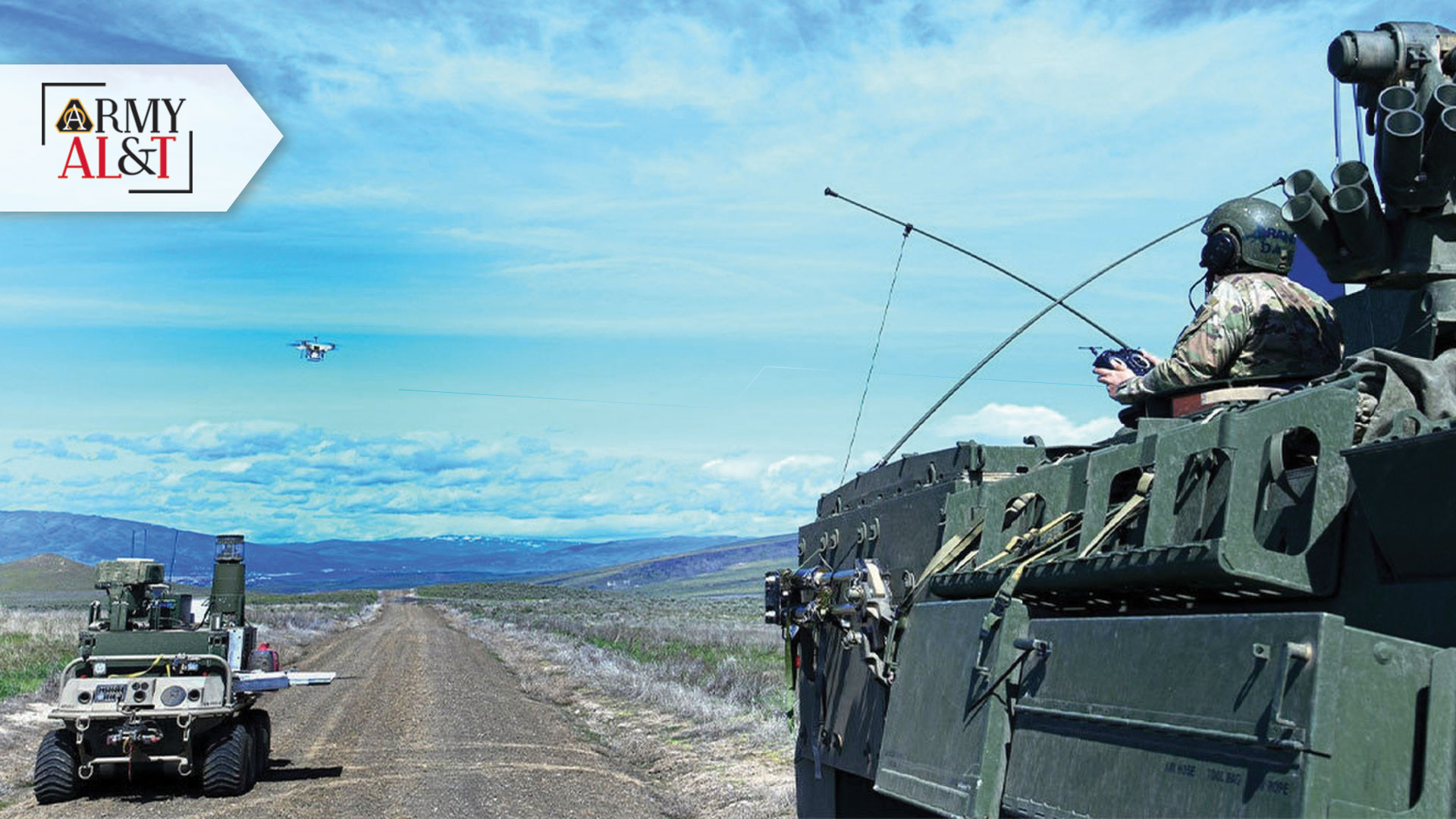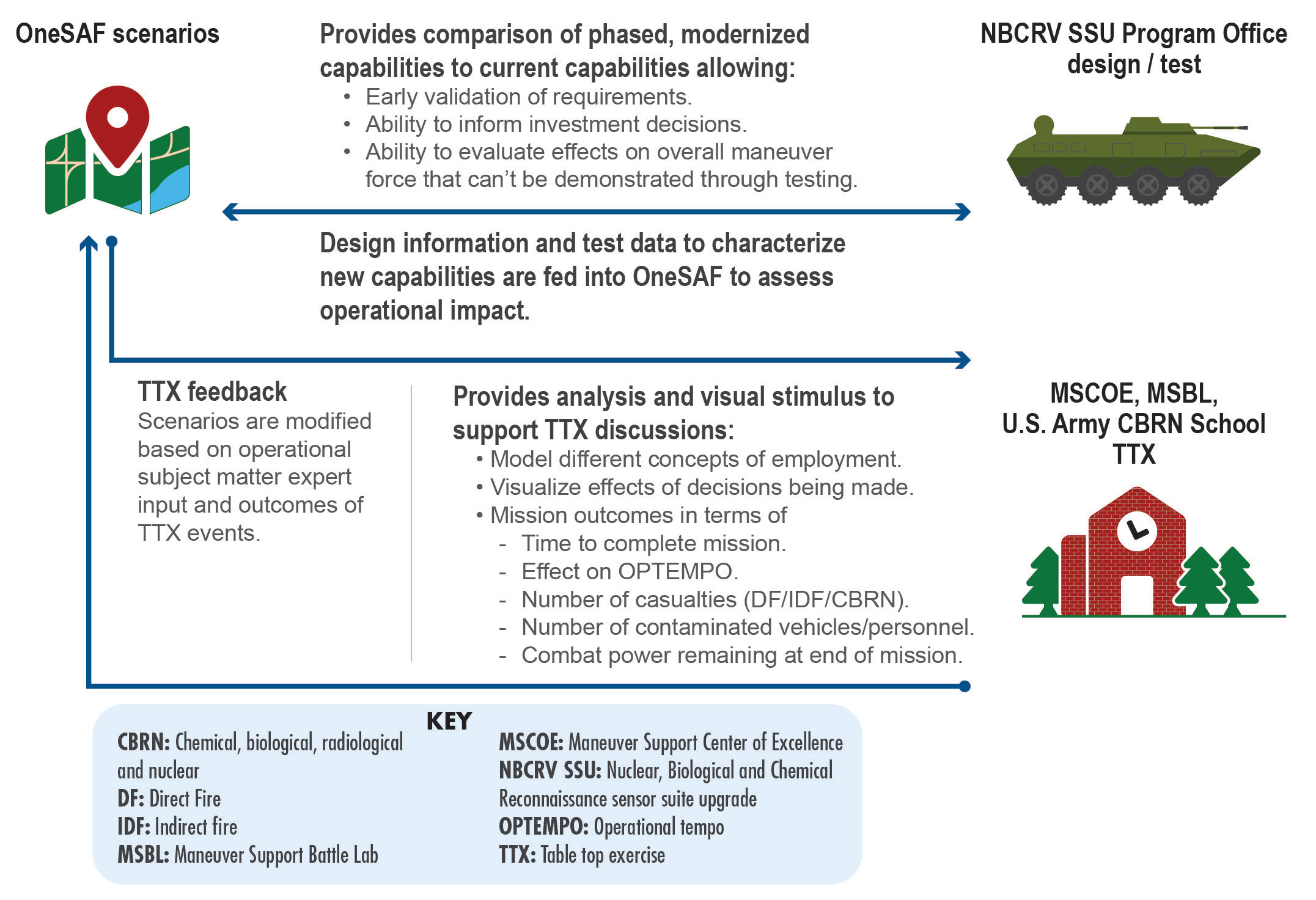
CONTAMINANT FREE ZONE: The NBCRV’s upgraded sensor suite package will use the Manned-unmanned teaming concept to allow detection of CBRN threats at a distance using unmanned air and ground vehicles, reducing the risk to warfighters by keeping them out of the contaminant. (Photo by U.S. Army)
JPEO-CBRND uses new acquisition approaches to keep pace with modernization.
by Gail Cayce-Adams and Kevin Joubert
As defense programs continue to integrate more and more advanced technologies, program managers are faced with the challenge of how best to manage these increasingly complex systems. To add to the chaos, many of today’s military programs integrate with other systems, requiring collaboration among groups of stakeholders that may have differing priorities. It is no longer possible to manage a program in a vacuum as a solitary effort. How each capability interfaces with and affects other capabilities on the battlefield must be considered early and often throughout a program’s life cycle.
To aid in managing the complexities of the acquisition process and the unique challenges involved in meeting the chemical, biological, radiological and nuclear (CBRN) defense needs of all U.S. military services, the Joint Program Executive Office for Chemical, Biological, Radiological and Nuclear Defense (JPEO-CBRND) is embracing the shift toward a digital engineering environment. One of the first JPEO-CBRND initiatives to enable this shift in how to do business was the creation of an analytical framework—a process that uses a combination of data, analysis methods and software tools to better manage its portfolio of products. As much as possible, the analytical framework replaces subjective and qualitative judgements with objective and quantitative analysis. The analytical framework team is tasked with providing analytical support to the joint project managers (JPMs) that fall under the JPEO-CBRND umbrella.
JPM CBRN Sensors develops, fields and sustains CBRN sensors, reconnaissance systems, mobile laboratory systems and obscuration capabilities for the Army. In 2018, JPM CBRN Sensors launched an effort to enhance the sensor suite package on the primary vehicle used by CBRN forces known as the Nuclear, Biological and Chemical Reconnaissance Vehicle (NBCRV). A phased modernization approach is being used to deliver new capabilities in increments known as capability sets, enabling faster delivery to the field. The upgraded sensor suite package will leverage unmanned air and ground vehicles using the Manned-unmanned teaming concept to allow detection of CBRN threats at a distance, reducing the risk to warfighters by keeping them out of the contaminant.
Manned-unmanned teaming is a new approach for the NBCRV sensor suite upgrade (SSU) program and they needed a means to quickly assess how these capabilities, along with other sensor suite enhancements, change the operational effectiveness of the NBCRV. The program was also looking for a way to gain insights into the impact of the new NBCRV SSU capabilities on the larger maneuver force, since this is difficult to determine through testing. The NBCRV SSU program reached out to the analytical framework team for help.
WHAT’S THE MISSION IMPACT?
The analytical framework team modeled five battalion-level scenarios representing the primary mission spaces for the NBCRV: offense; defense; tactical road march; movement to contact; and reception, staging, onward movement and integration. The scenarios are run in the combat simulation, OneSAF, to help understand the effects of new NBCRV SSU capabilities within the different mission spaces and to explore employment options for the unmanned systems.
Videos of the scenarios running within OneSAF were used to support the Mounted CBRN Reconnaissance and Surveillance Table Top Exercise held at the Maneuver Support Center of Excellence at Fort Leonard Wood, Missouri, in November 2019. The videos were used as conversation starters before the table top exercise discussions. This has proven to be an effective way for participants to visualize how operations are likely to play out and has served as an added benefit derived from the modeling efforts. Insights gleaned from the table top exercise as well as future coordination between the analytical framework team and Maneuver Support Center of Excellence, the Maneuver Center of Excellence and the U.S. Army CBRN School will be used to ensure the operational accuracy of the scenarios. Upon completion of this effort, the scenarios will be used to perform in-depth analysis for the NBCRV SSU program as each new capability set is developed.

COMBAT SIMULATOR: Scenarios are run in OneSAF to help understand the effects of new NBCRV SSU capabilities within the different mission spaces and to explore employment options for the unmanned systems. (Image by Gail Cayce-Adams, JPEO-CBRND)
NEW APPROACHES
In an effort to develop a repeatable, data-driven approach to examining the tradeoff between performance factors (e.g. speed versus power) the analytical framework team has recently expanded its use of decision support tools and engineering-level value models. These tools are used to select the most viable solutions from the pool of candidate systems during different phases of the acquisition life cycle, enabling a reduction in both cost and operational risk. The analytical framework team has been able to combine objective performance traits, modeled performance and program metrics such as cost and schedule, into utility models. The combination of these models, along with face-to-face stakeholder sensitivity analyses, has led to increased consensus and confidence in system selections.
The use of the tradeoff methods outlined above have paid dividends, but the team is looking to understand not just system-level trades, but higher level ones as well. Currently the tradeoffs would be between system performance metrics, like speed or weight. For instance, faster and lighter may be better but you can’t be both fast and light. However, the next step is to move from system performance level to combat effectiveness level. Does a faster system really increase survivability in combat? Or does the weight of a system have a larger effect on survivability in combat, perhaps? Currently, experts provide input on the importance of things such as speed and weight to the utility of a system. In the near future, we will use expert opinion less and the results from combat models more.
Rather than looking at what improvements to a particular system buy, it is now possible to use OneSAF to consider whether improvements in one functional area, such as detection, provides more benefit than improvements in another functional area, such as protection. For instance, is it preferable to have CBRN suits with better thermal comfort or to have a detector with faster response time?
The NBCRV will be the first JPEO-CBRND system to use OneSAF to examine these types of cross-commodity trades.
FUTURE WORK
With the success achieved so far with the creation of the analytical framework, JPEO-CBRND is taking additional steps to fully embrace the shift toward a digital engineering environment through improved data management techniques and more reliance on models and simulation.
Previously, CBRN data lived in disparate, isolated sources that were not readily available to those who may have needed it. This led to duplication of effort to produce needed data or use of data that was not necessarily the latest and best to support decision-making. To correct this, JPEO-CBRND has initiated an effort to create a centralized CBRN data repository to ensure everyone has access to the same validated data sets and to make sure knowledge is preserved.
The repository will hold all data pertaining to CBRN capabilities, including programmatic data such as cost, schedule and performance as well as modeling and simulation inputs and outputs, test data and any other data generated over the course of a program’s life cycle. Sources for the data will be listed, as well as a point of contact who can be reached for more information. That point of contact will have the responsibility for making sure the data is up to date. Storing data in a centralized repository will allow it to be updated one time and then made available to all, reducing errors and ensuring that the same, consistent data is being used at all times. As we adopt more digital engineering principles, we hope to develop the digital thread that will connect all phases of the program’s life cycle, so that when data is updated, it will automatically disseminate out to each place it is being used, such as component-level models, engineering drawings, inputs for combat models and test plans. As a simple example, if the name of a system component were to change, the ideal process would be that the point of contact for that component would log into the centralized data repository and update the name, which would then be automatically updated everywhere else that the component name is used.
JPEO-CBRND is also embracing the use of models and simulations at each stage of the program life cycle, from item-level engineering models that inform system designs, to trade-space models that examine ways to reduce cost and improve performance, to combat simulations that demonstrate the mission impact of new capabilities.
CONCLUSION
The JPEO-CBRND end goal is to put into place the architecture and necessary processes to create a digital environment that will remove the manual processes in existence today in favor of automated ones, creating a continuum across all phases of a program’s life cycle, from concept to disposal. This will help create a more efficient acquisition process by reducing manual work, ensuring an audit trail throughout a program’s life cycle and creating a shared understanding among all program stakeholders of the issues impacting their programs.
For more information, contact Lori Remeto, Director of Analytical Framework for JPEO-CBRND, at lori.c.remeto.civ@mail.mil.
GAIL CAYCE-ADAMS is an operations research analyst and serves as the lead for combat analytics for the JPEO-CBRND analytical framework team. She holds an M.S. in systems management and operations research from the Florida Institute of Technology and a B.S. in computer science from the University of Maryland, Baltimore County. She is Level III certified in engineering and Level I certified in program management.
KEVIN JOUBERT has worked in every part of the acquisition life cycle during his 20 years of government experience in the chemical and biological protection area. He is a Level III certified system engineer, with a B.S. in chemical engineering from McNeese State University and a B.S. in biology from the University of Louisiana at Lafayette.
Read the full article in the Summer 2020 issue of Army AL&T magazine.
Subscribe to Army AL&T News – the premier online news source for the Army Acquisition Workforce.
![]() Subscribe
Subscribe







